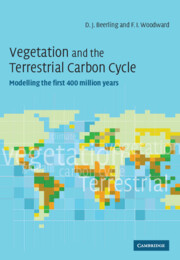Book contents
- Frontmatter
- Contents
- Preface
- Acknowledgements
- 1 Introduction
- 2 Investigating the past from the present
- 3 Climate and terrestrial vegetation
- 4 Climate and terrestrial vegetation of the present
- 5 The late Carboniferous
- 6 The Jurassic
- 7 The Cretaceous
- 8 The Eocene
- 9 The Quaternary
- 10 Climate and terrestrial vegetation in the future
- 11 Endview
- References
- Index
2 - Investigating the past from the present
Published online by Cambridge University Press: 09 August 2009
- Frontmatter
- Contents
- Preface
- Acknowledgements
- 1 Introduction
- 2 Investigating the past from the present
- 3 Climate and terrestrial vegetation
- 4 Climate and terrestrial vegetation of the present
- 5 The late Carboniferous
- 6 The Jurassic
- 7 The Cretaceous
- 8 The Eocene
- 9 The Quaternary
- 10 Climate and terrestrial vegetation in the future
- 11 Endview
- References
- Index
Summary
Introduction
The time frame of this book is rather less than 500 million years, the time over which the Earth's terrestrial surface became first colonised and subsequently dominated by land plants. Land plants now constitute over 90% of the world's biomass, a true measure of their quantitative dominance in the biosphere. The fossil evidence of this takeover (e.g. Niklas et al., 1983) is sporadic and incomplete, often frustratingly so. However, the sequence from the first miniature vascular land plant, Cooksonia, of the Silurian period, about 430 Ma (Edwards et al., 1983), to the massive Lepidodendron tree of the Carboniferous period (300 Ma; DiMichele & DeMaris, 1987) indicates that the evolution of complex and large plant structures was very rapid, whilst communities of different species of plants would have been the rule as early as the Devonian period (395 Ma; Chaloner & Sheerin, 1979; Banks, 1981; Edwards, 1996).
The prospect of predicting or modelling the activities of land plants over 400 million years ago appears a task doomed to failure. However, we know that all land plants have derived the carbon for their structures from organic molecules constructed in the process of photosynthesis. The process of photosynthesis is very ancient and the ubiquitous CO2-fixing enzyme, ribulose 1,5-bisphosphate carboxylase/oxygenase (rubisco), which may reach as much as 50% of the soluble protein in leaves, is thought to have a marine origin along with chemolithotrophs at about 3500 Ma (Badger & Andrews, 1987).
- Type
- Chapter
- Information
- Vegetation and the Terrestrial Carbon CycleThe First 400 Million Years, pp. 9 - 22Publisher: Cambridge University PressPrint publication year: 2001



